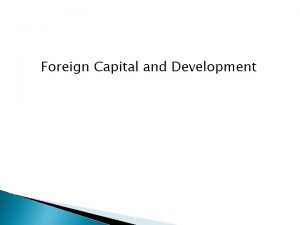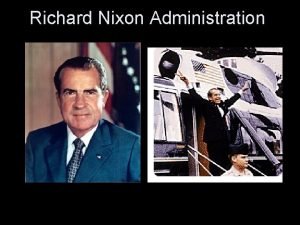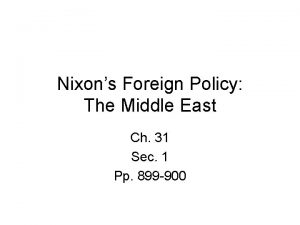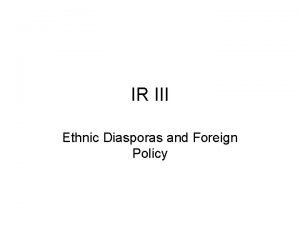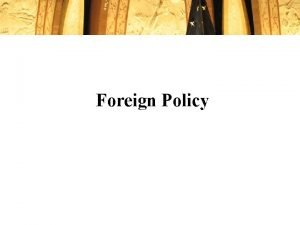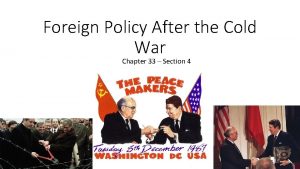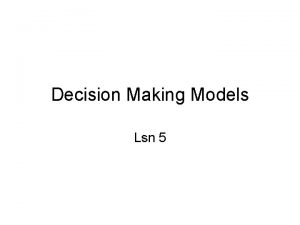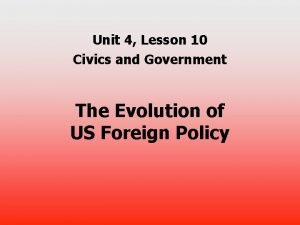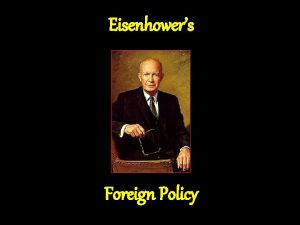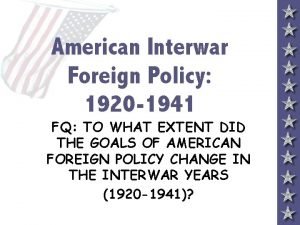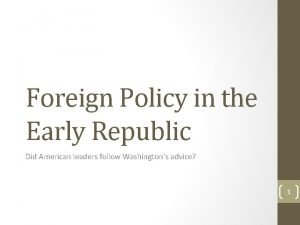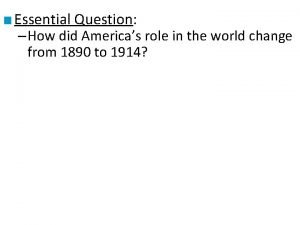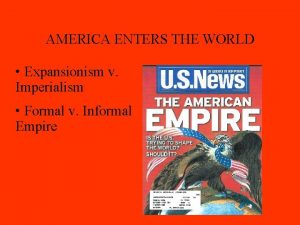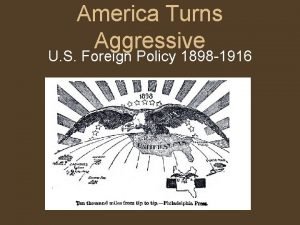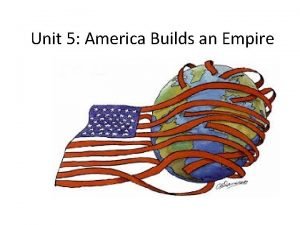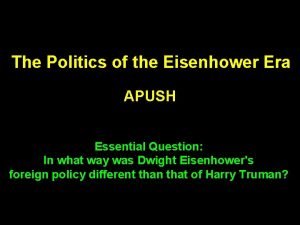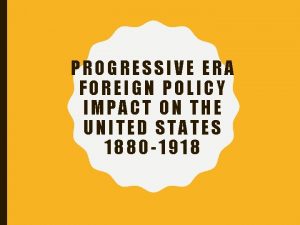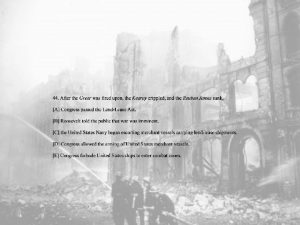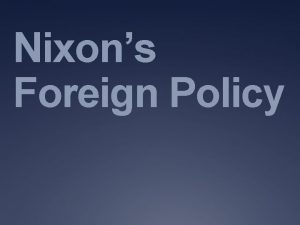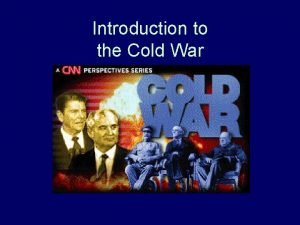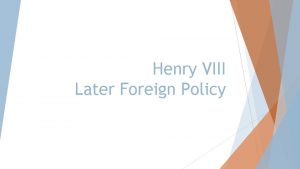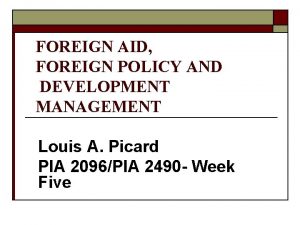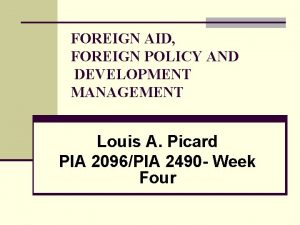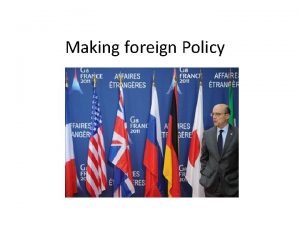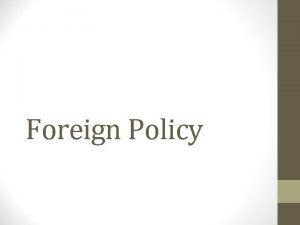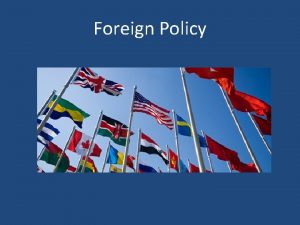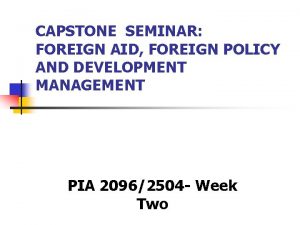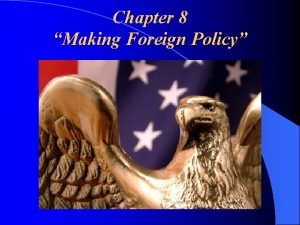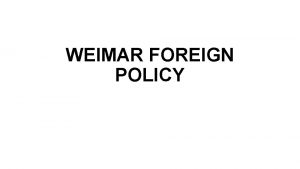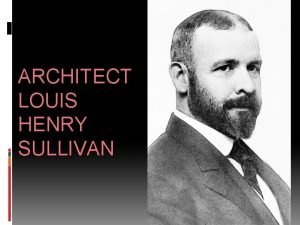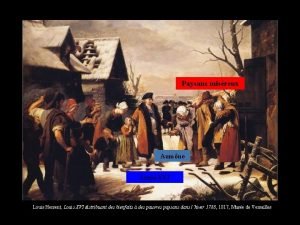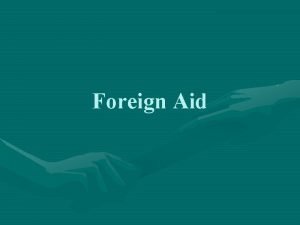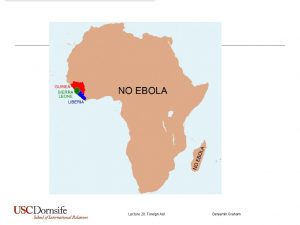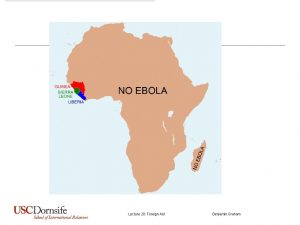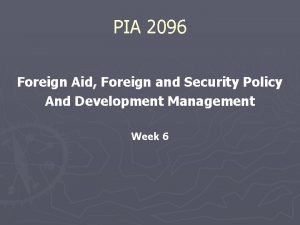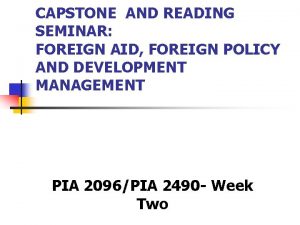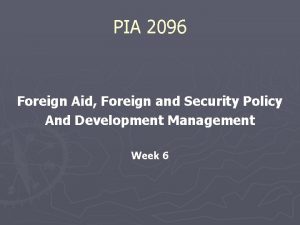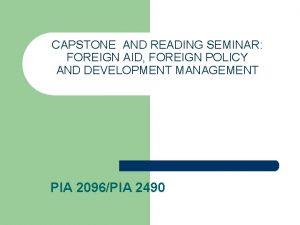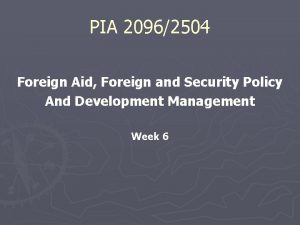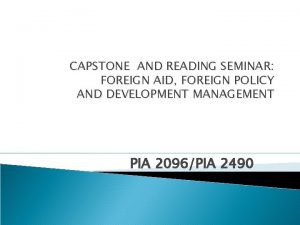FOREIGN AID FOREIGN POLICY AND DEVELOPMENT MANAGEMENT Louis



























![Quote: n America is what everyone here wants to be like…. [i] n [i] Quote: n America is what everyone here wants to be like…. [i] n [i]](https://slidetodoc.com/presentation_image_h2/ac815ec5fe4c12abfc55667b7a4abc02/image-28.jpg)


- Slides: 30

FOREIGN AID, FOREIGN POLICY AND DEVELOPMENT MANAGEMENT Louis A. Picard PIA 2096/PIA 2490 - Week Four

Foreign Aid Course Foreign Aid Policy: The First Decade

The Counter Narrative GOAL: To conceive of a rival hypothesis that could reverse perceived reality and provides a possible policy option for future attention because of its very plausibility.

Foreign Aid After World War II Four Components This Week: n The Marshall Plan n Point Four and n The First Decade: 1948 -1960

Quote: North Africa, 1943 n “Behold, we the American holy warriors have arrived…. we have come to set you free. ”[i] n [i] U. S. script of radio broadcast from the U. S. S. Texas, October, 1943 quoted in Rick Atkinson, An Army at Dawn: The War in Africa, 1942 -1943 (New York: Henry Holt & Company, 2002), p. 34.

Time Frame n Lend Lease, 1941 n Foreign Economic Administration, 1942 n Global Leadership and Unconditional Surrender, 1943

Time Frame n Ad Hoc Assistance: 1944 -1946 n Greece and Turkish Assistance, 1947 n Marshall Plan, 1948 n Point Four Program, 1950

Stated Goals Goal One: Development of Economic and Human Resources Worldwide Goal Two: Stop the spread of Communism

The United Nations Roal n United Nations Reconstruction and Rehabilitation Administration n Beginnings of Post-War Multi- Lateral organizations

Post-War Planning n Based on Unconditional Surrender n Marshall Plan Targets: Europe, including Germany, Japan, Korea and China (Taiwan) n Temporary Infusion of Cash: Massive but limited (five years) n Focus on Infrastructure- Human Skills Existed

Point Four n Truman’s State of the Union Speech, 1950 n Expansion of Marshall Plan to Developing World n Expanded Role for Economic Cooperation Administration (ECA) n Include long range Health and Education Goals

Domestic Management Systems and International Influences Keynes and Financial management during 1950 s – 1960 s Growth—domestic development funds with bilateral technical assistance n Relationship between Command economy and the market n Keynesianism and the controversial models Soviet Union, India n

U. S. Foreign Policy Goal: n Enlightened Self Interest n Take Off Point Optimism n Support for Asian and African Dependent Territories

The Price Tag U. S. Dollars: $8 Billion, 1952 Dollars

The Cold War n We aid other countries with whom our relationships may be more nearly correct than cordial, because we believe that it is in our interests to maintain friendly contacts with their governments and their people and to keep them from going behind the Iron Curtain. [i] n [i] Speech by Arthur Z. Gardiner, Director United States Operations Mission in Viet-nam, address given to the Saigon Rotary Club on September 22, 1960 (Washington, D. C. : Department of State and U. S. Government Printer, 1961).

Major International Relations Terms International Conflict During the Cold War n Structural realism; n Realpolitik n Balance of power vs. Transnationalism n Bipolarity vs. Multi-polarity

First Decade: 1. Development was based on a model of self-help and individual initiative. It was the absence of individual initiative that caused under-development. Humanitarian aid had to be changed to developmental principles in order for it to be successful. Wise guidance to indigenous peoples on the part of the change agent was built into this principle.

First Decade- 2 2. Education and training (and the technical assistance that went with it) were the key to development. Human resource development and training were thus predefined components of development efforts. Through targeting semi-skilled workers, through a kind of bridging training, a void could be filled in human resource terms.

First Decade-3 3. There was a need to change values. This in part went back to the faith based organizations that dominated technical assistance in the first half of the 20 th century. This required a minimum technical assistance commitment for 3 -5 years.

First Decade-4 4. Crucial to development was the need to reduce tensions and foster understanding between groups. Conflict resolution was at the center of discussions about political development and later governance components of the development effort.

First Decade-5 5. It was possible to distinguish between elite projects that allowed only an indirect impact on development and grassroots activities which, though limited would impact directly on disadvantaged peoples.

The Problem: As early as the 1950 s, observers identified the self-sustaining growth of institutions as a primary goal of foreign aid. However, U. S. foreign aid policy was often characterized by fragmentation and contradictory goals.

Results: n Skepticism n Unfulfilled Goals n No Take Off Point n Foreign Aid Permanent not Temporary

Question: n Keynesian Assumptions for LDCs n Macro-Economic Planning n Shortcomings of Program Planning

The Problem with Planning 1. The allocation of agency or contractor roles was not always clearly defined in program terms; 2. Within the Point Four program proper, responsibility for project formulation and supervision sometimes seemed unnecessarily diffuse; 3. In the management of foreign aid, there was too little provision for basic program planning and assessment particularly in terms of the entirety of the government’s technical assistance activities

The Problem with Planning-2 3. In the management of foreign aid, there was too little provision for basic program planning and assessment particularly in terms of the entirety of the government’s technical assistance activities; 4. Relations of oversea field missions to the staffs of the U. S. diplomatic missions in countries, where economic and technical aid programs were in progress, were sometimes unclear;

The Problem with Planning-3 5. Finally, officials had not given sufficient attention to ways and means of correlating U. S. government lending policies with the probable financing and maintenance requirements of developmental technical assistance projects when completed.
![Quote n America is what everyone here wants to be like i n i Quote: n America is what everyone here wants to be like…. [i] n [i]](https://slidetodoc.com/presentation_image_h2/ac815ec5fe4c12abfc55667b7a4abc02/image-28.jpg)
Quote: n America is what everyone here wants to be like…. [i] n [i] Mark Hertsgaard, The Eagle’s Shadow: Why America Fascinates and Infuriates the World (New York: Picador Books, 2003), p. 4.

Three Views of Foreign Aid- A Reminder 1. Part of Balance of Power- Carrot and Stick Approach (based on exchange Theory 2. Commercial Promotion: Focus on International Trade 3. Humanitarian Theory: Moral Imperative

Focus Next Week n Motivations n Multilateral Beginnings n Contracts and Non-Governmental Organizations n Vietnam: The Early Years
 Foreign policy of louis philippe
Foreign policy of louis philippe Louis vuitton vl
Louis vuitton vl Here you are too foreign for home
Here you are too foreign for home Fdi meaning
Fdi meaning First aid merit badge first aid kit
First aid merit badge first aid kit Greenhill medical centre
Greenhill medical centre 1790 foreign policy
1790 foreign policy What was thomas jefferson foreign policy
What was thomas jefferson foreign policy Nixons foreign policy
Nixons foreign policy Nixons foreign policy
Nixons foreign policy Actors in foreign policy
Actors in foreign policy Definition of foreign policy by scholars
Definition of foreign policy by scholars Chapter 33 section 4 foreign policy after the cold war
Chapter 33 section 4 foreign policy after the cold war Rational actor model cuban missile crisis
Rational actor model cuban missile crisis Unit 4 lesson 10 american foreign policy
Unit 4 lesson 10 american foreign policy Truman foreign policy vs eisenhower
Truman foreign policy vs eisenhower Interwar america
Interwar america Lesson 5: american foreign policy
Lesson 5: american foreign policy Hitler's foreign policy timeline
Hitler's foreign policy timeline Foreign policy in the early republic
Foreign policy in the early republic Foreign policy imperialism
Foreign policy imperialism Foreign policy imperialism
Foreign policy imperialism Andrew johnson foreign policy
Andrew johnson foreign policy President taft’s foreign policy emphasized
President taft’s foreign policy emphasized Foreign policy
Foreign policy John foster dulles apush
John foster dulles apush Dollar diplomacy pros
Dollar diplomacy pros Foreign policy shift
Foreign policy shift Nixons vietnamization policy
Nixons vietnamization policy Conclusion of foreign policy
Conclusion of foreign policy Henry viii foreign policy 1509-1529
Henry viii foreign policy 1509-1529



